3.5 Surf
We saw earlier how a wave begins to be affected by the seabed when the water depth is about half the wavelength and how waves slow down to a speed dictated only by the depth at water depths of a twentieth of the wavelength. This slowing of the waves brings them closer together and makes them progressively steeper. Ultimately, the wave becomes unstable and breaks.
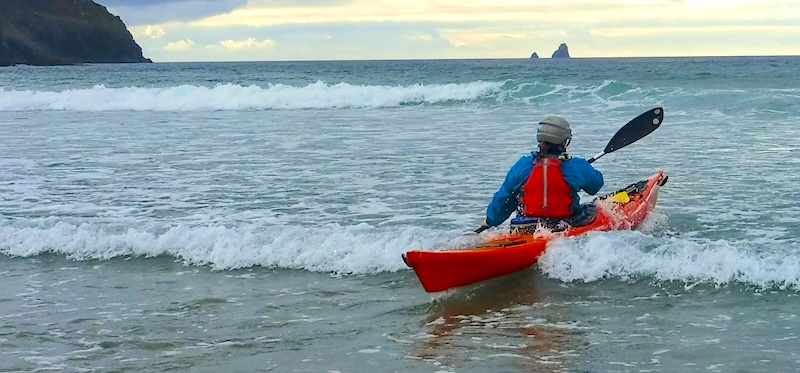
Small breaking waves
A range of factors affect when a wave breaks, but it tends to happen when:
The wavelength of the wave reduces to about 7 times the wave height
The depth of the water reduces to around 1.3 times the wave height
3.5.1 Waves and beaches
The way that the wave breaks depends on how steep the beach is:

Types of breaking waves. Breaker schematic diagrams by Kathirine Sentas, photos by H.E. Power. From Power, Hannah E. “Breaking waves.” Sandy Beach Morphodynamics. Elsevier, 2020. 103-130.
Spilling waves break slowly on beaches with a shallow gradient, losing their energy over an extended distance. These are often enjoyable waves to surf in a sea kayak. On steeper beaches, the waves become steeper too, losing their energy more rapidly. The top of the wave starts to curl over, creating a plunging wave. Plunging waves are sought out by experienced surfers, as they tend to be steep and powerful, but they tend to be challenging to surf into a long sea kayak.
On even steeper beaches, the waves plunge or collapse straight onto the beach, creating a ‘dumping’ wave. These can break powerfully onto a kayak, pin a swimmer to the beach, and possibly pull them under the wave and away from the beach in the undertow that these waves create.
Dumping wave on steep stony beach. Fortunately, this wave isn’t too big, making launching awkward rather than dangerous
As the beach gets very steep, the waves don’t really break properly, instead they collapse or surge up the steep beach. In both cases the wave loses energy very rapidly, and the surge or collapsing wave can be very powerful.
Launching and landing on beaches with spilling waves tends to be fairly straightforward. When the waves start plunging, things get more tricky. By the time they’re dumping, collapsing or surging right onto the beach, launching and landing become awkward in smaller waves and dangerous in larger waves.
Beaches with shallow gradients typically have a long distance between the waterline at high water and low water. So while they might form nice safe surf, there can be along distance to carry the boat if you happen to be there at low tide. This may enable you to identify shallow angled beaches from a chart or a large scale OS map - look for a large green drying area on the chart. Steeper beaches can be recognised on the chart by the water becoming deep close offshore.
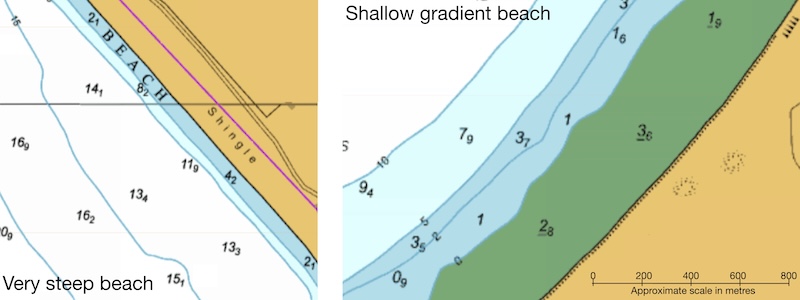
Steep and shallow gradient beaches shown on charts at the same scale. Note that the steep beach shows no drying area and the depth increases to 10m within about 100m of the shoreline. By contrast, the shallow gradient beach has a large drying area (shown in green) beyond which the depth increases gradually.
Sometimes the steepness of a beach can vary with the height of the tide. This is worth watching out for - a beach that has a shallow angled lower part and a steeper upper part might be easy to launch from at low tide, but present a nightmare landing spot with dumping waves at high tide.
3.5.2 Surf height
Remember that as waves move into shallower water, they bunch up and their energy gets concentrated into a smaller area. As a result, surf waves can be taller than the offshore swell. This is especially true of long period waves which have very long wavelengths in deep water.
Here’s a plot that gives a rough estimate of breaking wave height based on swell height and period
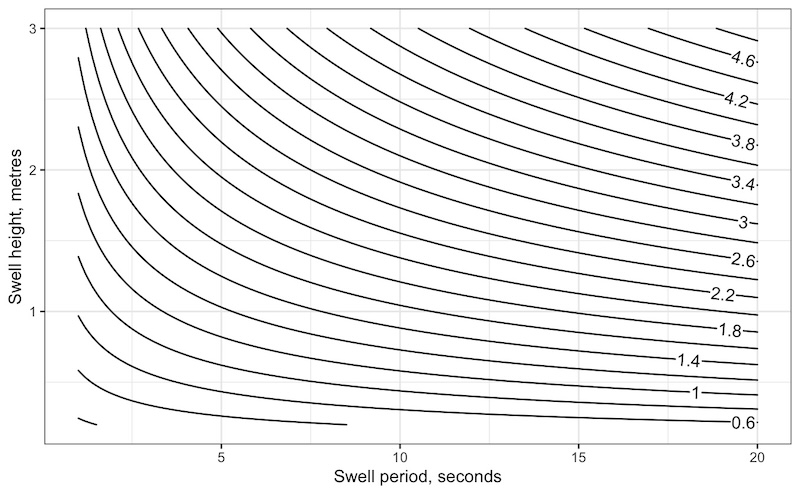
For example, if the swell height is 1 meter and the swell period is 15 seconds, we’d estimate the surf height at 1.8 meters.
Be aware that this is a very approximate estimate that ignores a lot of factors!
Be careful when looking at forecasts of surf height. Often the ‘Hawaiian’ measurement is used which measures the wave from the back - giving a measurement that is half the height of the wave face! It’s a good idea to check what convention the forecast is using.
The surf is affected by any wind blowing across the beach. Onshore winds create wind driven waves that can create confused conditions in the surf zone. The waves break earlier and hence aren’t as steep. By contrast, an offshore wind tends to lead to cleaner surf, with well-defined waves from the underlying swell. The wave break later, becoming steeper and a bit taller.
3.5.3 Surf zone features
3.5.3.1 The surf zone
Let’s look in detail at the final moments of a (spilling) wave before it gets to the beach:

The area beyond the surf zone is sometimes referred to as ‘out back’ by surfers and kayakers. It should be a fairly quiet place to take a rest, regroup after launching through the surf or take a moment to plan a surf landing. The key thing is to make sure that you really are out back - larger waves will break further out and may catch you by the surprise. The waves in this area may still be pushing you gently towards the sure, so staying here might require the odd bit of paddling.
Surf kayaks are fast compared to surfers, and we can often surf ‘green’ waves before they break, starting our rides before any whitewater appears on the wave face. When the waves do break, they sometimes do so at a point, the whitewater extends left and right across the wave face. In this ‘outer surf zone’, the waves can be powerful and change shape rapidly. It’s a challenging, but fun place to surf a kayak, given the right waves.
Once they reach the ‘inner surf zone’ or, colloquially, the ‘soup’ the waves no longer have a defined face. What’s left are piles of broken whitewater rolling in towards the beach. In big surf, it can require some power to punch through these waves. Kayaks positioned side on to these broken waves will get pushed sideways into the beach.
Eventually, the wave swashes up onto the beach. There’s no power left in the wave, but the coming and going of water can make getting into boats and putting spraydecks on awkward.
3.5.3.2 Rip currents
Unlike deep water waves, surf waves carry water along with them towards the beach. This water has to get back out to sea and it sometimes does so through defined deeper channels through the surf zone known as ‘rip currents’ or simply ‘rips’. These currents act over short distances (they usually dissipate in in two to three times width of the surf zone). They pose no great hazard to kayakers - indeed, they can sometimes provide an easy way to get out through the surf with less breaking waves. However, they run fast enough to carry swimmers rapidly out to sea.
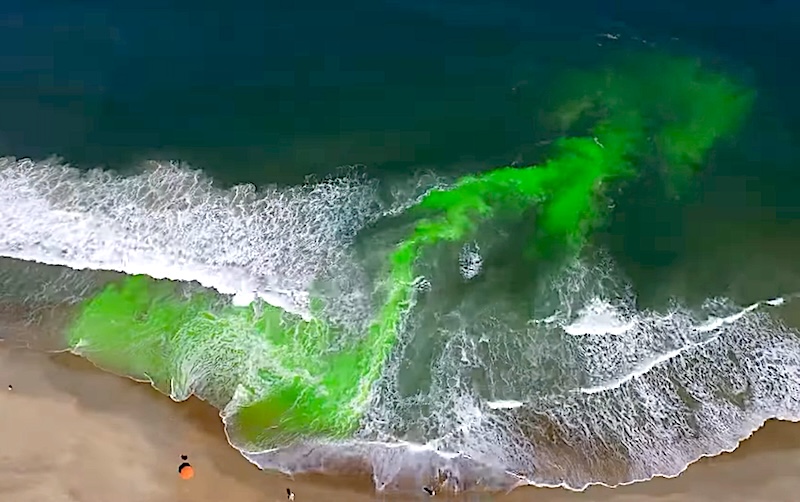
Rip current revealed by fluorescent dye. Notice the current running out through a gap in the breaking waves. The current dissipates beyond the surf zone. Image: UNC Coastal Studies Institute/NOAA
Rip currents are not always easy to spot. They will be easier to see from the beach than on the water. Look for:
Darker patches of water, indicating greater depth
Areas with fewer breaking waves
Rippled areas of the surface, surrounded by smoother water
Foamy water or sand/sediment being carried out to sea
Rips don’t always show all these features.
Rips can flow directly out to sea, but sometimes flow at an angle to the shoreline. They can often be found at the edges of a beach, by rocky headlands.
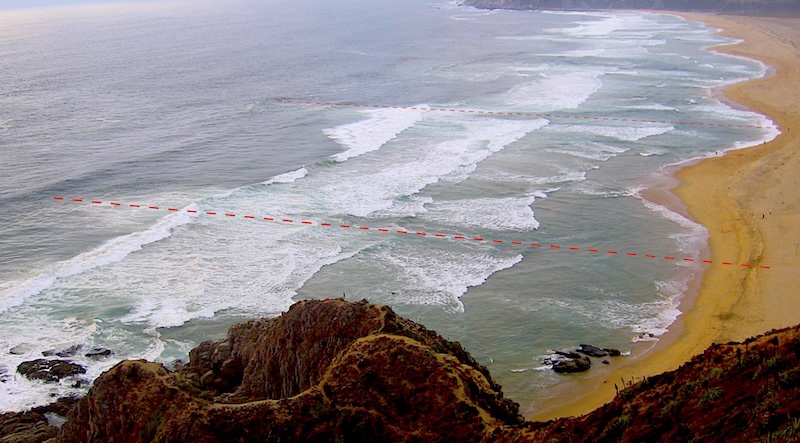
Beach with several rips, two of which are marked by dashed red lines. Notice less breaking waves and aerated water carried out beyond the surf zone. Photo: NOAA / Cecilia and Randy Lascody.
A swimmer caught in a rip is unlikely to be able to swim against it. Instead, the right thing to do is to swim parallel to the beach to get out of the current and into an area where the waves will push them back inshore. A kayaker rescuing a swimmer in a rip may also find it easier to paddler parallel to the beach than trying to fight the current with the drag of the swimmer.
3.5.3.3 Longshore currents
Waves don’t always meet the beach exactly perpendicular and the returning water current can have a component parallel to the beach. As a result, there is often a current running along a beach. This current doesn’t normally run very fast, but it can displace groups of kayakers playing in the surf from their start point. To keep the group together, it’s often helpful to pick a landmark on or behind the beach to try and stay opposite.